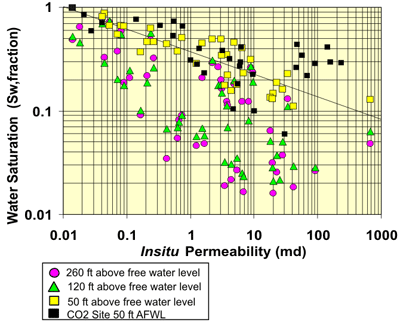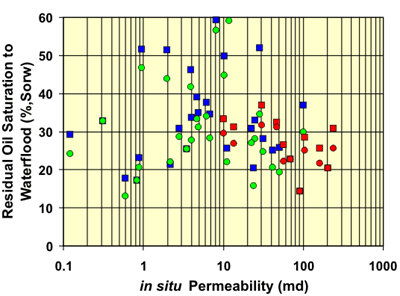Correlation of Textural Properties with Permeability
Previous investigation showed the relationship between permeability and rock textural parameters including:
-
Connectivity Index - An index ranging from 1 to 4 representing the degree of connection between oomolds as observed at 10X-20X:
-
Packing Index - An index from 1 to 4 representing the packing density of oomolds:
Size - An estimate of the average oomold diameter in phi units -
Archie Matrix Porosity Index - base on Archie’s (1952) second parameter for describing matrix
 .
.

Archie Cementation Exponent
Oomoldic limestones from Kansas and globally exhibit extremely high Archie cementation exponents. This is consistent with the interpretation that the oomoldic pores are similar to micro-vugs. Modified Archie parameters for the Carter-Colliver Lease rocks are: m=1.36, a=9.59. Conversely, if m is considered to change with porosity then m can be predicted for the higher porosity rocks using: m = 0.05*Porosity(%) + 1.9. Cementation exponents are near 2.0 in the bioclastic wackestone overlying the ‘C’ zone. Cementation exponents increase into the top of the ‘C’ and then decrease with increasing depth to the base. This is associated with the higher porosity at the top of the ‘C’ zone but is also influenced by pore structure changes associated with the unconformity surface.

“Irreducible” Water SaturationWith finer pores in the matrix surrounding large oomolds
it is important to understand capillary pressure relationships since
high porosity may not be directly associated with effective oil porosity.
Correlations of “Irreducible” water saturations indicate
that Swi increases with decreasing permeability as exhibited by many
rocks. Saturation increases with decreasing permeability following
the relation: |
|
| |
Residual Oil Saturation to WaterfloodResidual oil saturation to waterflood (Sorw) is a critical variable. Sorw increases then decrease with increasing permeability (k). At lower k, higher Swi must be associated with lower Sorw. At high k good connectivity promotes low Sorw. Intermediate permeability rock have large pore bodies and smaller pore throats which supports oil-globule snap-off and trapping. |
|
|
e-mail : webadmin@kgs.ku.edu
Last updated May 2003
http://www.kgs.ku.edu/PRS/publication/2003/ofr2003-32/P1-09.html


